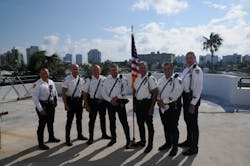Seeking a longer (battery) life
Lt. David Hernandez works in the investigations & support division at Miami Beach PD. His agency recently swapped out radio batteries hoping for less down-time spent recharging.
The problem:
Batteries that don’t hold a charge. “In our experience the OEM batteries don’t last us a year. …they get to a point where ... you get four or five hours out of them at most,’ says Hernandez.
Miami officers work minimum 10-hour shifts, and sometimes additional detail. They are not equipped with in-car radios, just walkie-talkie. [When the battery dies] they need to call in on their cell phone to tell dispatch they’re OK, and then get back to their car to grab a second battery. These are not ideal conditions for on-call service.
The purchase:
Two years ago Miami PD purchased about 500 – 600 Impact Power Technology replacement batteries (and chargers), and will be placing a purchase request for another 50 or so.
Reported features:
- Two–year warranty
- Fits easily inside department’s
- radio holsters
- Lightweight
- Long battery life
Hernandez looked at the Motorola XTS3000 and 5000 models, but the company does make other batteries for additional radio brands.
Hernandez says he paid slightly more per battery than the OEM cost, but “you’re getting a battery that’s got 2-3 times the amount of battery life to use during a shift. In the long run you’re saving money and keeping the user in the field.”
He feels batteries and similar radio accessories are often overlooked in communications upgrades and overhauls, when in reality things like shoulder mics and battery holsters are just as important as the actual radio system because it needs to pair up with the radio and make it functional.
The buying process:
Hernandez put out an Invitation to Quote and reports eight companies responded with prices. “We demanded that the procurement department retained a demo battery and demo charger from every company that wanted us to buy from them. I wound up with five or six batteries from these different companies, and we told them we would send back the charger but not the battery…because we were going to cut it open after we got done testing it.” These batteries were then put through the paces. The batteries were cut apart, submerged, and tried with different radios, holsters and chargers.
“At the end, we felt this particular product was one of the best fits for us.”
MPD sets aside some money in its annual budget to buy batteries (annual replacement funding), and will disseminate older batteries to folks who work more often in the office before recycling.
Planning ahead
Hernandez said the city is in the process of putting together an RFP to piggyback off another county’s replacement of Motorola radios, and is looking to buy a new P25 Phase 2 compliant radio system and all the hardware that goes with it. They are also looking to put radios in police cruisers. But that’s an upgrade for another day.
Making the move to digital
Director Robert Stack heads up E911 efforts at Lexington (Ky) Division of Police and began a $10 mil implementation product for new radios.
The problem:
A suspect connection. “Our fire division was operating on a Harris EDACS radio system that had been deemed ‘end of life’ by the manufacturer. Police on the other hand was on an aging 40-year-old analog radio system and needed to be narrow banded… it was more efficient to go out and buy a new radio system to replace the two aging ones.
They switched out handhelds on the police side, buying Tait PT9100s.
Pervasive interference was another concern. Says Stack “It was not uncommon to get bleed over from agencies in Ohio using the same frequencies that were deemed to be far enough away by the FCC to use the same frequencies, but yet we were having bleed-over from them.”
The purchase:
An Airbus (formerly Cassidian) trunked digital 800 MHz radio system.
Lexington partnered with the Blue Grass Airport on this sizeable overhaul. The airport owns a portion of the radio system and own a 3-channel multicast off the PD’s radio system. “Our partnership has worked out very well; it has been a cost-savings for the city because we don’t have to pay for a tower out in that end of the county,” says Stack. Since then, smaller jurisdictions have expressed interest in joining the radio system.
Reported features:
- Full encryption
- Nonproprietary hardware means
- the agency is free to obtain replacement part through open sources.
- Competitive pricing
- Transparency during the
- purchasing process
- Identifies who the radio user is via unique subscriber user ID “If somebody has difficulty speaking because of the environment they’re in, we at least know who’s trying to transmit.”
A word on transition:
“There’s always some burn-in, but that’s to be expected…nothing earth-shattering. On a digital system you either have the radio or you don’t have the radio,” says Stack. “There’s no in-between”.

Sara Scullin
Sara Scullin was the Editor of Law Enforcement Technology magazine, a monthly business-to-business publication that covers technology trends and best practices for public safety managers. LET is part of SouthComm Law Enforcement Media, which also publishes Law Enforcement Product News and Officer.com. Sara had covered the law enforcement industry since March 2008.



